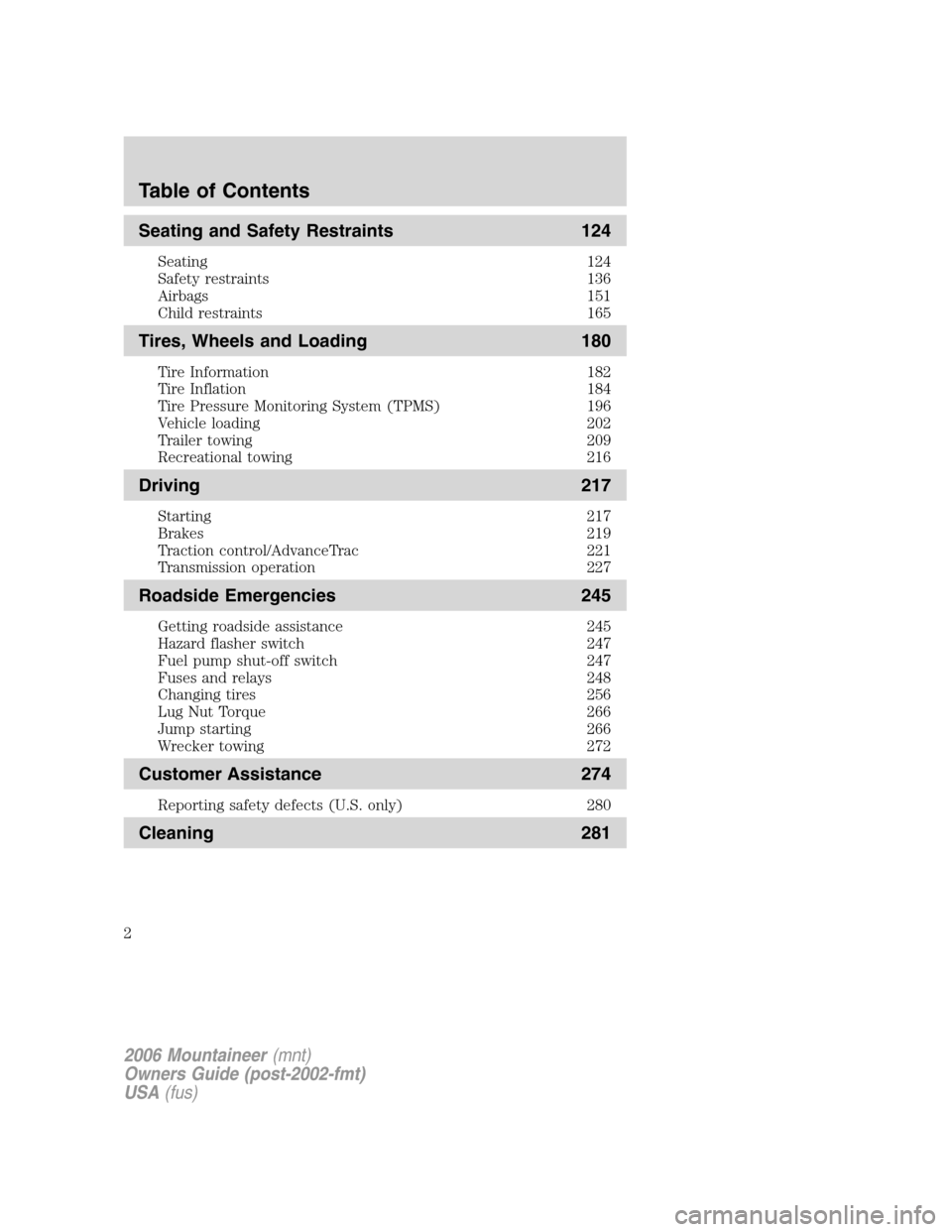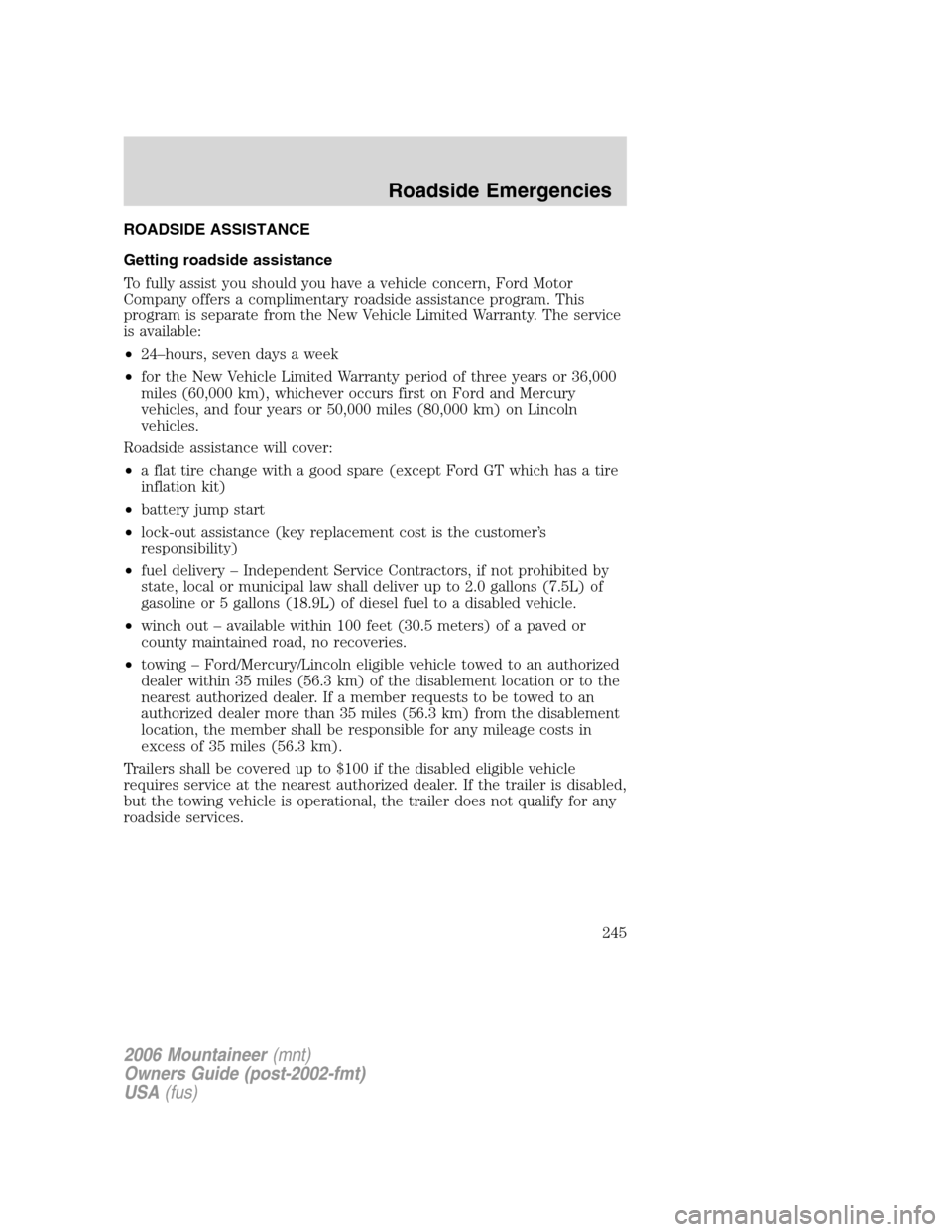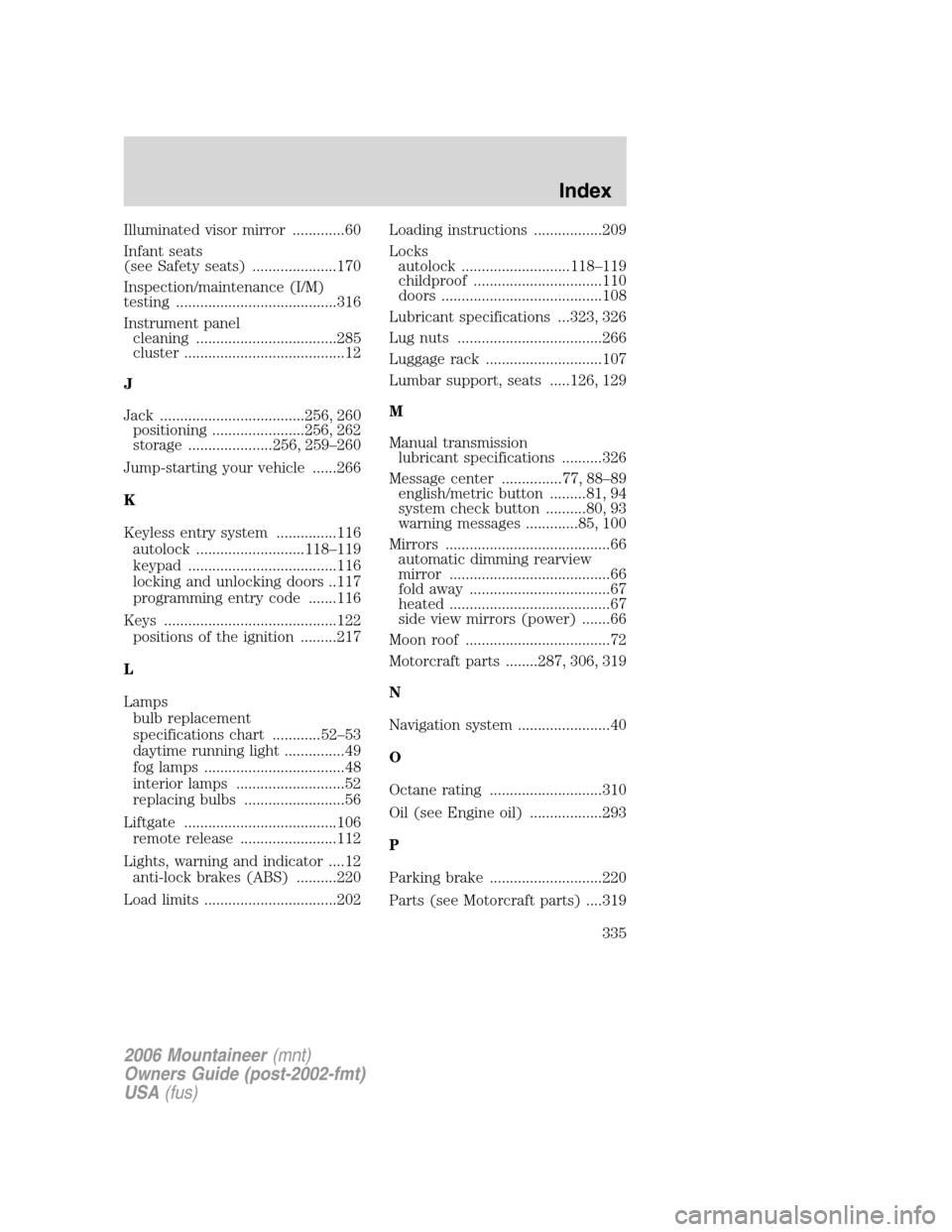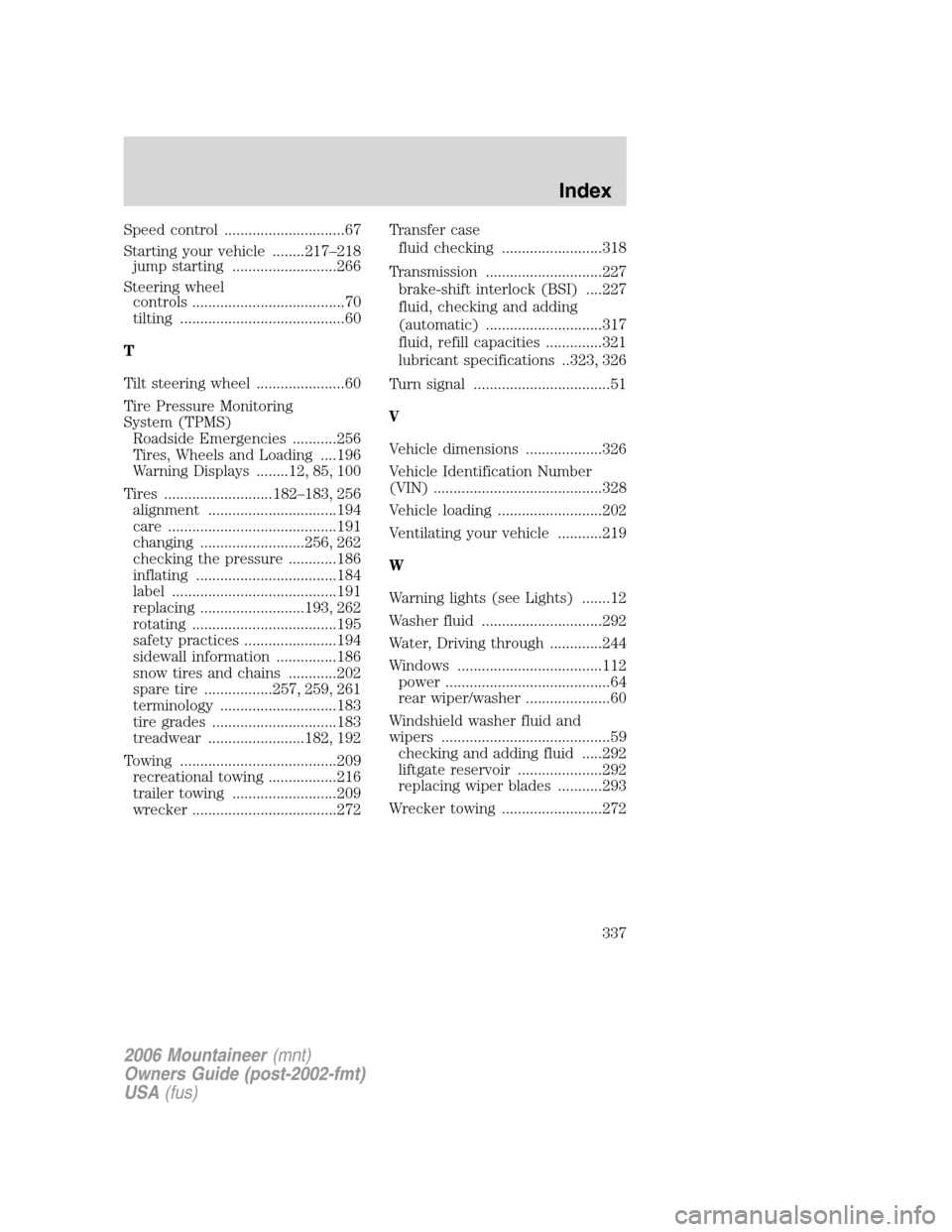jump start Mercury Mountaineer 2006 Owner's Manuals
[x] Cancel search | Manufacturer: MERCURY, Model Year: 2006, Model line: Mountaineer, Model: Mercury Mountaineer 2006Pages: 344, PDF Size: 2.66 MB
Page 2 of 344

Seating and Safety Restraints 124
Seating 124
Safety restraints 136
Airbags 151
Child restraints 165
Tires, Wheels and Loading 180
Tire Information 182
Tire Inflation 184
Tire Pressure Monitoring System (TPMS) 196
Vehicle loading 202
Trailer towing 209
Recreational towing 216
Driving 217
Starting 217
Brakes 219
Traction control/AdvanceTrac 221
Transmission operation 227
Roadside Emergencies 245
Getting roadside assistance 245
Hazard flasher switch 247
Fuel pump shut-off switch 247
Fuses and relays 248
Changing tires 256
Lug Nut Torque 266
Jump starting 266
Wrecker towing 272
Customer Assistance 274
Reporting safety defects (U.S. only) 280
Cleaning 281
Table of Contents
2
2006 Mountaineer(mnt)
Owners Guide (post-2002-fmt)
USA(fus)
Page 245 of 344

ROADSIDE ASSISTANCE
Getting roadside assistance
To fully assist you should you have a vehicle concern, Ford Motor
Company offers a complimentary roadside assistance program. This
program is separate from the New Vehicle Limited Warranty. The service
is available:
•24–hours, seven days a week
•for the New Vehicle Limited Warranty period of three years or 36,000
miles (60,000 km), whichever occurs first on Ford and Mercury
vehicles, and four years or 50,000 miles (80,000 km) on Lincoln
vehicles.
Roadside assistance will cover:
•a flat tire change with a good spare (except Ford GT which has a tire
inflation kit)
•battery jump start
•lock-out assistance (key replacement cost is the customer’s
responsibility)
•fuel delivery – Independent Service Contractors, if not prohibited by
state, local or municipal law shall deliver up to 2.0 gallons (7.5L) of
gasoline or 5 gallons (18.9L) of diesel fuel to a disabled vehicle.
•winch out – available within 100 feet (30.5 meters) of a paved or
county maintained road, no recoveries.
•towing – Ford/Mercury/Lincoln eligible vehicle towed to an authorized
dealer within 35 miles (56.3 km) of the disablement location or to the
nearest authorized dealer. If a member requests to be towed to an
authorized dealer more than 35 miles (56.3 km) from the disablement
location, the member shall be responsible for any mileage costs in
excess of 35 miles (56.3 km).
Trailers shall be covered up to $100 if the disabled eligible vehicle
requires service at the nearest authorized dealer. If the trailer is disabled,
but the towing vehicle is operational, the trailer does not qualify for any
roadside services.
2006 Mountaineer(mnt)
Owners Guide (post-2002-fmt)
USA(fus)
Roadside Emergencies
245
Page 266 of 344

2. Stow the wheel ornament (if removed) in a safe location in the vehicle
(such as the glove box or jack stowage compartment) so it will not
become damaged. Re-install the wheel ornament onto the wheel once the
tire is repaired or replaced.
3. Stow the jack and tools in their respective locations, making sure they
are fully secured so they do not rattle when you drive.
WHEEL LUG NUT TORQUE SPECIFICATIONS
Retighten the lug nuts to the specified torque at 50–100 miles (80–160
km) after any wheel disturbance (rotation, flat tire, wheel removal, etc.).
Lug nut socket
size/Bolt sizeWheel lug nut torque*
lb.ft. N•m
Lug nut socket size:
3�4” (19 mm) hex
Bolt size:1�2x20100 135
* Torque specifications are for nut and bolt threads free of dirt and
rust. Use only Ford recommended replacement fasteners.
When a wheel is installed, always remove any corrosion, dirt or
foreign materials present on the mounting surfaces of the wheel
or the surface of the wheel hub, brake drum or brake disc that
contacts the wheel. Ensure that any fasteners that attach the rotor to
the hub are secured so they do not interfere with the mounting
surfaces of the wheel. Installing wheels without correct metal-to-metal
contact at the wheel mounting surfaces can cause the wheel nuts to
loosen and the wheel to come off while the vehicle is in motion,
resulting in loss of control.
Note:If there is corrosion on the area where the wheel contacts the
hub, apply a thin film of grease or anti-seize compound on that area.
JUMP STARTING
The gases around the battery can explode if exposed to flames,
sparks, or lit cigarettes. An explosion could result in injury or
vehicle damage.
Batteries contain sulfuric acid which can burn skin, eyes and
clothing, if contacted.
2006 Mountaineer(mnt)
Owners Guide (post-2002-fmt)
USA(fus)
Roadside Emergencies
266
Page 267 of 344

Do not attempt to push-start your vehicle. Automatic
transmissions do not have push-start capability; doing so may
damage the catalytic converter.
Preparing your vehicle
When the battery is disconnected or a new battery is installed, the
transmission must relearn its shift strategy. As a result, the transmission
may have firm and/or soft shifts. This operation is considered normal and
will not affect function or durability of the transmission. Over time, the
adaptive learning process will fully update transmission operation.
1.Use only a 12–volt supply to start your vehicle.
2. Do not disconnect the battery of the disabled vehicle as this could
damage the vehicle’s electrical system.
3. Park the booster vehicle close to the hood of the disabled vehicle
making sure the two vehiclesdo nottouch. Set the parking brake on
both vehicles and stay clear of the engine cooling fan and other moving
parts.
4. Check all battery terminals and remove any excessive corrosion before
you attach the battery cables. Ensure that vent caps are tight and level.
5. Turn the heater fan on in both vehicles to protect any electrical
surges. Turn all other accessories off.
Connecting the jumper cables
1. Connect the positive (+) jumper cable to the positive (+) terminal of
the discharged battery.
Note:In the illustrations,lightning boltsare used to designate the
assisting (boosting) battery.
+–+–
2006 Mountaineer(mnt)
Owners Guide (post-2002-fmt)
USA(fus)
Roadside Emergencies
267
Page 269 of 344

4. Make the final connection of the negative (-) cable to the ground stud
located toward the front of the vehicle (forward of the battery) on the
raidator support. Keep the negative (-) cable away from the battery and
the carburetor/fuel injection system.Do notuse fuel lines, engine rocker
covers or the intake manifold asgroundingpoints. Ensure that the
battery shield is properly installed before jump starting the vehicle.
Do not connect the end of the second cable to the negative (-)
terminal of the battery to be jumped. A spark may cause an
explosion of the gases that surround the battery.
5. Ensure that the cables are clear of fan blades, belts, moving parts of
both engines, or any fuel delivery system parts.
Jump starting
1. Start the engine of the booster vehicle and run the engine at
moderately increased speed.
2. Start the engine of the disabled vehicle.
3. Once the disabled vehicle has been started, run both engines for an
additional three minutes before disconnecting the jumper cables.
++-
-
2006 Mountaineer(mnt)
Owners Guide (post-2002-fmt)
USA(fus)
Roadside Emergencies
269
Page 271 of 344

4. Remove the jumper cable from the positive (+) terminal of the
disabled vehicle’s battery.
After the disabled vehicle has been started and the jumper cables
removed, allow it to idle for several minutes so the engine computer can
relearn its idle conditions.
+–+–
2006 Mountaineer(mnt)
Owners Guide (post-2002-fmt)
USA(fus)
Roadside Emergencies
271
Page 333 of 344

washing ....................................281
waxing .....................................281
wheels ......................................282
wiper blades ............................284
Climate control (see Air
conditioning or Heating) ............43
Clock adjust
6-CD in dash .............................32
AM/FM/CD .................................22
AM/FM/Tape/CD .......................27
Compass, electronic ....................83
calibration .................................85
set zone adjustment ...........84, 98
Console ..................................63–64
overhead ....................................61
rear ............................................64
Controls
power seat ...............................126
steering column ........................70
Coolant
checking and adding ..............300
refill capacities ................304, 321
specifications ..................323, 326
Cruise control
(see Speed control) ....................67
Customer Assistance ................245
Ford Extended Service
Plan ..........................................278
Getting assistance outside the
U.S. and Canada .....................278
Getting roadside assistance ...245
Getting the service you
need .........................................274
Ordering additional owner’s
literature .................................279
Utilizing the
Mediation/Arbitration
Program ...................................277D
Daytime running lamps
(see Lamps) ................................49
Defrost
rear window ..............................47
Dipstick
automatic transmission
fluid ..........................................317
engine oil .................................293
Doors
lubricant specifications ..........323
Driveline universal joint and
slip yoke ....................................318
Driving under special
conditions ..................234, 239, 242
sand .........................................240
snow and ice ...........................243
through water .................241, 244
Dual automatic temperature
control (DATC) ...........................43
DVD system .................................40
E
Electronic message center ...77, 88
Emergencies, roadside
jump-starting ..........................266
Emergency Flashers .................247
Emission control system ..........314
Engine ........................................326
cleaning ...................................283
coolant .....................................300
fail-safe cooling .......................305
idle speed control ...................298
lubrication
specifications ..................323, 326
refill capacities ........................321
2006 Mountaineer(mnt)
Owners Guide (post-2002-fmt)
USA(fus)
Index
333
Page 335 of 344

Illuminated visor mirror .............60
Infant seats
(see Safety seats) .....................170
Inspection/maintenance (I/M)
testing ........................................316
Instrument panel
cleaning ...................................285
cluster ........................................12
J
Jack ....................................256, 260
positioning .......................256, 262
storage .....................256, 259–260
Jump-starting your vehicle ......266
K
Keyless entry system ...............116
autolock ...........................118–119
keypad .....................................116
locking and unlocking doors ..117
programming entry code .......116
Keys ...........................................122
positions of the ignition .........217
L
Lamps
bulb replacement
specifications chart ............52–53
daytime running light ...............49
fog lamps ...................................48
interior lamps ...........................52
replacing bulbs .........................56
Liftgate ......................................106
remote release ........................112
Lights, warning and indicator ....12
anti-lock brakes (ABS) ..........220
Load limits .................................202Loading instructions .................209
Locks
autolock ...........................118–119
childproof ................................110
doors ........................................108
Lubricant specifications ...323, 326
Lug nuts ....................................266
Luggage rack .............................107
Lumbar support, seats .....126, 129
M
Manual transmission
lubricant specifications ..........326
Message center ...............77, 88–89
english/metric button .........81, 94
system check button ..........80, 93
warning messages .............85, 100
Mirrors .........................................66
automatic dimming rearview
mirror ........................................66
fold away ...................................67
heated ........................................67
side view mirrors (power) .......66
Moon roof ....................................72
Motorcraft parts ........287, 306, 319
N
Navigation system .......................40
O
Octane rating ............................310
Oil (see Engine oil) ..................293
P
Parking brake ............................220
Parts (see Motorcraft parts) ....319
2006 Mountaineer(mnt)
Owners Guide (post-2002-fmt)
USA(fus)
Index
335
Page 337 of 344

Speed control ..............................67
Starting your vehicle ........217–218
jump starting ..........................266
Steering wheel
controls ......................................70
tilting .........................................60
T
Tilt steering wheel ......................60
Tire Pressure Monitoring
System (TPMS)
Roadside Emergencies ...........256
Tires, Wheels and Loading ....196
Warning Displays ........12, 85, 100
Tires ...........................182–183, 256
alignment ................................194
care ..........................................191
changing ..........................256, 262
checking the pressure ............186
inflating ...................................184
label .........................................191
replacing ..........................193, 262
rotating ....................................195
safety practices .......................194
sidewall information ...............186
snow tires and chains ............202
spare tire .................257, 259, 261
terminology .............................183
tire grades ...............................183
treadwear ........................182, 192
Towing .......................................209
recreational towing .................216
trailer towing ..........................209
wrecker ....................................272Transfer case
fluid checking .........................318
Transmission .............................227
brake-shift interlock (BSI) ....227
fluid, checking and adding
(automatic) .............................317
fluid, refill capacities ..............321
lubricant specifications ..323, 326
Turn signal ..................................51
V
Vehicle dimensions ...................326
Vehicle Identification Number
(VIN) ..........................................328
Vehicle loading ..........................202
Ventilating your vehicle ...........219
W
Warning lights (see Lights) .......12
Washer fluid ..............................292
Water, Driving through .............244
Windows ....................................112
power .........................................64
rear wiper/washer .....................60
Windshield washer fluid and
wipers ..........................................59
checking and adding fluid .....292
liftgate reservoir .....................292
replacing wiper blades ...........293
Wrecker towing .........................272
2006 Mountaineer(mnt)
Owners Guide (post-2002-fmt)
USA(fus)
Index
337